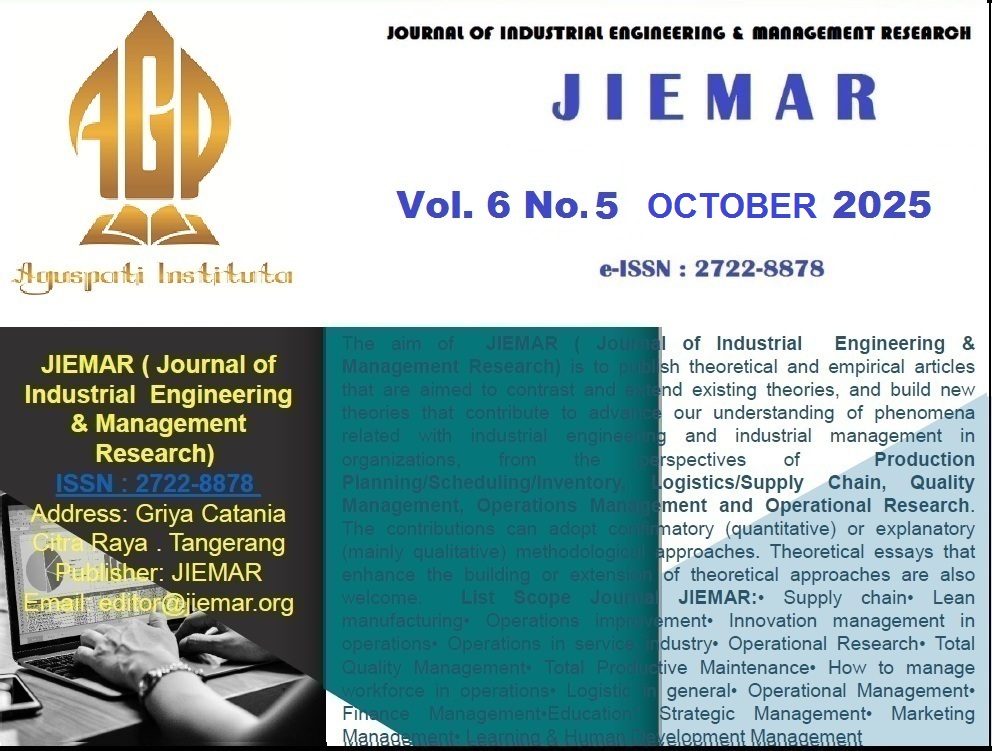The Influence of Threats and Budget Capability on the Development of Domestic Alpahankam Technology
Abstract
The development of domestic defense and security equipment technology (Alpalhankam) is a strategic factor in strengthening national sovereignty. External threats of military, economic, and technological nature, along with the government’s budget capacity, are two main factors influencing the success of defense technology development. This study aims to analyze the influence of external threats and budget capacity on the development of Alpalhankam technology in Indonesia. The research method used is quantitative, with a population consisting of staff and experts in the defense industry, and a sample of 50 respondents selected through purposive sampling. Data were collected using questionnaires, interviews, and documentation, and analyzed through validity and reliability tests, descriptive statistics, and linear regression. The results show that external threats have a positive and significant influence on technology development (B = 0.431, p = 0.000), while budget capacity also has a positive and significant influence with a higher coefficient (B = 0.512, p = 0.000). The correlation among variables indicates a strong relationship, with an R² of 0.622, suggesting that 62.2% of the variation in technology development can be explained by the two independent variables. These findings highlight the importance of synergy between threat mitigation and budget optimization to enhance the capacity and independence of the national defense industry.
References
M. R. DeVore, “Armaments after autonomy: Military adaptation and the drive for domestic defence industries,” J. Strateg. Stud., vol. 44, no. 3, pp. 325–359, 2021.
F. Dorn, “Defence spending for Europe’s security–How much is enough,” Intereconomics–Review Eur. Econ. Policy, vol. 59, no. 4, pp. 204–209, 2024.
K.-H. Röhl, H. Bardt, and B. Engels, “A new era for the defense industry? Security policy and defense capability after the Russian invasion of Ukraine,” IW-Policy Paper, 2023.
O. P. Das, “The Making of Technological Innovation Ecosystem in Defence Sector,” J. Def. Stud., vol. 18, no. 3, pp. 44–65, 2024.
H. Hidayaturahmi and S. Farida, “Pembinaan Industri Pertahanan dan Keamanan: Sebuah Tinjauan Konteks dan Konten Kebijakan,” J. Pembang. dan Adm. Publik, 2022.
D. Wahyudi, B. Bakrie, and T. Rosa, “Defense industry policy analysis regarding efforts to increase production of defense equipment for national security (case study at the defense industry policy committee),” J. Entrep. Bus., vol. 2, no. 1, pp. 1–9, 2024.
O. Cheberyako and D. Herus, “Budgetary security of Ukraine in the context of a large-scale war,” Univ. Econ. Bull., vol. 18, no. 4, pp. 50–59, 2023.
M. M. Pukhova, I. A. Merkulina, and D. Y. Bashkov, “Developing public–private partnership projects to enhance innovation capability in the defence industry,” Economies, vol. 9, no. 4, p. 147, 2021.
E. McCusker, Defense budget transparency and the cost of military capability. American Enterprise Institute, 2022.
B. Nurpatria, A. R. Ras, and I. Supriyadi, “Analisis Substitusi Impor Guna Mendukung Kemandirian Industri Kendaraan Taktis Di Bidang Pertahanan Dan Keamanan Indonesia,” J. Pertahanan Bela Negara, vol. 12, no. 2, pp. 107–133, 2022.
R. Greenway et al., “A Conservative Defense Budget for Fiscal Year 2025,” Heritage Foundation Special Report, 2024.
G. T. Marek, D. Brążkiewicz, M. Kacprzak, Z. Ciekanowski, and L. Elak, “Efficiency of Defence Expenditure Management in the Context of Escalating Security Threats,” Eur. Res. Stud. J., vol. 28, no. 2, pp. 665–675, 2025.
N. M. Miloradović, “Contemporary security challenges and their impact on the increase of the military spending and the budget for the development and procurement of weapons and military equipment,” Vojn. delo, vol. 75, no. 3, pp. 30–47, 2023.
Y. Petlenko, L. Tarnu, B. Shchehliuk, and S. Nate, “Enhancing the Effectiveness of Defence Planning Through the Implementation of Capability-Based Budgeting and Civilian Control,” Access to Just. E. Eur., p. 265, 2023.
I. Okromtchedlishvili, “Capability-Based Planning and Program Budgeting Approaches: Enhancing Sustainability and Utility of Defense Forces,” J. Def. Resour. Manag., vol. 14, no. 2, pp. 21–32, 2023.
T. Ambodo, G. E. Saputro, and U. N. Pratiwi, “Implementasi Kebijakan Pengembangan Teknologi Industri Pertahanan Dalam Mendukung Kemandirian Alat Peralatan Pertahanan,” Nusant. J. Ilmu Pengetah. Sos., vol. 9, no. 3, pp. 587–600, 2022.
M. A. Marpaung, “Sentralisasi Industri Pertahanan dalam Strategi Indonesia Menghadapi Eskalasi Ancaman Pasca AUKUS,” J. Diplomasi Pertahanan, vol. 8, 2022.
N. A. Pambudhi, “Analisis Pembangunan Ibukota Negara Baru dan Dampaknya Terhadap Anggaran Pertahanan,” J. Kewarganegaraan, vol. 8, no. 1, pp. 70–79, 2024.
A. Sarjito, “Kebijakan Pertahanan Strategis: Mendefinisikan Ulang Pengadaan Alat Peralatan Pertahanan dan Keamanan sebagai Investasi, Bukan Pemborosan,” J. Gov. Sci. Stud., vol. 3, no. 2, pp. 61–76, 2024.
W. G. W. H. Z. Almubaroq and H. J. R. Saragih, “Tantangan Pengembangan Industri Pertahanan Indonesia,” J. Kewarganegaraan, vol. 6, no. 2, 2022.
A. Sugiarto and G. R. Deksino, “Optimalisasi Produk Pengembangan Teknologi Industri Pertahanan (Bangtekindhan) Guna Meningkatkan Kesiapan Alat Peralatan Pertahanan (Alpalhan) dalam Rangka Mendukung Tugas Pokok TNI,” J. Educ. Dev., vol. 10, no. 2, pp. 345–349, 2022.
R. E. Prasetiyo, A. N. Coutsar, S. Aprilya, M. Tobing, and A. Endy, “Potensi Penggunaan Energi Ramah Lingkungan Pada Sistem Daya Gerak Alpalhankam dalam Mendukung Strategi Pertahanan Indonesia,” G-Tech J. Teknol. Terap., vol. 7, no. 3, pp. 923–938, 2023.







